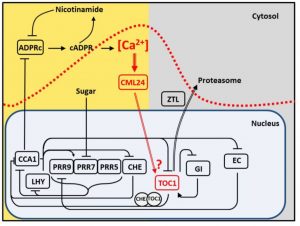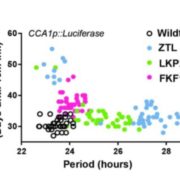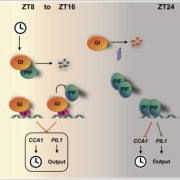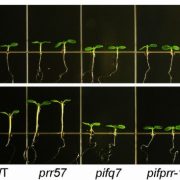Circadian oscillations of cytosolic free calcium regulate the Arabidopsis circadian clock (Nature Plants)
 The circadian rhythm confers competitive advantages by coordinating the physiology and behavior of biological systems. The internal clock in eukaryote organisms comprises feedback loops, and in Arabidopsis most of them involve negative transcriptional regulation events as well as post-transciptional, post-translational and metabolic regulation. In this paper, Martí Ruiz et al. show a direct association between the oscillations of cytosolic free Ca2+ and the circadian rhythms. They demonstrate that the expression levels of CCA1 HIKING EXPEDITION (CHE), a repressor of the clock core gene CIRCADIAN CLOCK ASSOCIATED1 (CCA1), is negatively correlated with Ca2+ oscillations. Further, they were able to link the Ca2+ oscillations to the circadian period regulation by studying mutants of the Ca2+ sensor calmodulin-like 24 (CML24). They found that mutations in CLM24 are epistatic to mutations in the clock gene TIMING OF CAB2 EXPRESSION1 (TOC1), and therefore these genes could be involved in the same circadian period regulation pathway. (Summary by Aime Jaskolowski) Nature Plants 10.1038/s41477-018-0224-8
The circadian rhythm confers competitive advantages by coordinating the physiology and behavior of biological systems. The internal clock in eukaryote organisms comprises feedback loops, and in Arabidopsis most of them involve negative transcriptional regulation events as well as post-transciptional, post-translational and metabolic regulation. In this paper, Martí Ruiz et al. show a direct association between the oscillations of cytosolic free Ca2+ and the circadian rhythms. They demonstrate that the expression levels of CCA1 HIKING EXPEDITION (CHE), a repressor of the clock core gene CIRCADIAN CLOCK ASSOCIATED1 (CCA1), is negatively correlated with Ca2+ oscillations. Further, they were able to link the Ca2+ oscillations to the circadian period regulation by studying mutants of the Ca2+ sensor calmodulin-like 24 (CML24). They found that mutations in CLM24 are epistatic to mutations in the clock gene TIMING OF CAB2 EXPRESSION1 (TOC1), and therefore these genes could be involved in the same circadian period regulation pathway. (Summary by Aime Jaskolowski) Nature Plants 10.1038/s41477-018-0224-8









